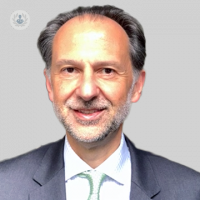Revolutionising treatment: The power and potential of high-intensity focused ultrasound (HIFU)
Written in association with:High-intensity focused ultrasound (HIFU) is an innovative and non-invasive medical technology that has revolutionised the treatment of various conditions, particularly in cancer care. HIFU harnesses the power of sound waves to target and destroy diseased tissue, offering patients a treatment option that minimises recovery time, reduces side effects, and avoids invasive surgery. This article explores the power and potential of HIFU, focusing on its applications, benefits, and how it works.

What is high-intensity focused ultrasound (HIFU)?
HIFU is a medical procedure that uses focused ultrasound waves to generate heat and target specific areas of tissue. The sound waves are directed towards the treatment area, increasing the temperature within the targeted tissue and destroying diseased or damaged cells without affecting the surrounding healthy tissue. This technology is widely used for treating conditions such as prostate cancer, uterine fibroids, and, more recently, other cancers and neurological conditions.
Unlike traditional surgical techniques, HIFU does not involve making incisions or causing trauma to healthy tissue, making it a safer and less invasive option for patients.
How does HIFU work?
HIFU works by focusing high-energy ultrasound waves on a precise area of the body. The focused energy causes tissue heating, leading to the destruction of diseased cells. The process can be compared to how sunlight, when concentrated through a magnifying glass, generates enough heat to ignite a specific point without affecting the surrounding area.
HIFU treatments are usually guided by imaging techniques like magnetic resonance imaging (MRI) or ultrasound, which provide real-time visualisation to ensure accuracy in targeting the area to be treated.
What conditions can HIFU treat?
HIFU has become an important tool in treating various medical conditions, particularly in the field of oncology and gynaecology. Some of the most common applications of HIFU include:
- Prostate cancer: HIFU is frequently used to treat localised prostate cancer. It provides an effective option for men seeking to avoid surgery or radiation therapy and offers the benefit of preserving surrounding tissue, reducing the risk of side effects such as incontinence or impotence.
- Uterine fibroids: For women with symptomatic uterine fibroids, HIFU provides a non-invasive option that can shrink fibroids and alleviate symptoms without the need for a hysterectomy or other invasive procedures.
- Liver and kidney cancers: In cases of liver and kidney cancer, HIFU is emerging as a promising treatment option, particularly for patients who are not suitable candidates for surgery or chemotherapy.
- Neurological conditions: Research into the use of HIFU for treating neurological conditions, such as essential tremor and Parkinson’s disease, is ongoing, showing potential for managing symptoms through precise targeting of brain tissue.
What are the benefits of HIFU?
HIFU offers several significant advantages compared to traditional treatments, including:
- Non-invasive: Since HIFU does not require incisions, it eliminates the risks associated with surgery, such as infection, bleeding, and longer recovery periods.
- Precision targeting: The ability to focus ultrasound energy on a specific area of tissue ensures that the surrounding healthy tissue remains unharmed, reducing side effects and improving patient outcomes.
- Minimal recovery time: Patients treated with HIFU typically experience shorter recovery periods and can often return to their normal activities within a few days, compared to the weeks or months required after surgery.
- Reduced side effects: Because HIFU minimises damage to healthy tissues, patients often experience fewer side effects compared to traditional treatments such as surgery or radiation therapy.
- Outpatient procedure: Many HIFU treatments can be performed on an outpatient basis, meaning patients do not need to be hospitalised overnight.
Is HIFU widely available?
While HIFU is increasingly being recognised as a viable treatment option for various conditions, it is not yet universally available. Access to HIFU depends on the type of condition being treated and the availability of the technology in healthcare facilities. However, as awareness of the benefits of HIFU continues to grow, more hospitals and specialised treatment centres are adopting this cutting-edge technology.
What are the potential limitations of HIFU?
Although HIFU has shown remarkable potential, it is not suitable for every patient or condition. In some cases, the size or location of the tumour may limit the effectiveness of the treatment. Additionally, long-term data on the outcomes of HIFU are still being gathered, as the technology is relatively new compared to traditional treatments. It is important for patients to discuss their individual circumstances with a healthcare professional to determine whether HIFU is the best option for them.
HIFU represents a powerful and transformative approach to treating a wide range of conditions, particularly in cancer care. Its non-invasive nature, precision, and ability to minimise side effects make it an attractive option for many patients. As research continues and the technology advances, the use of HIFU is expected to expand, providing new opportunities for improved patient outcomes in both cancer treatment and beyond.


